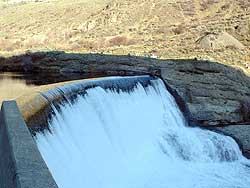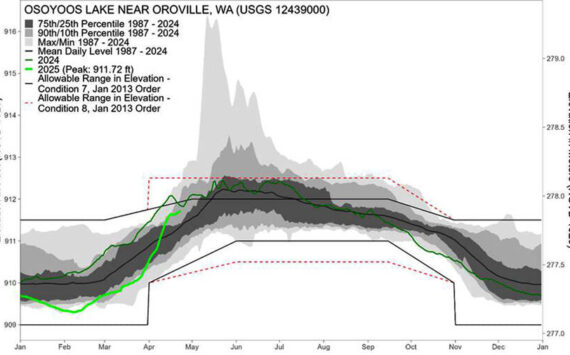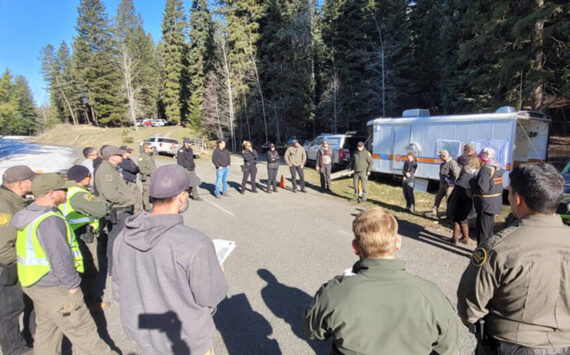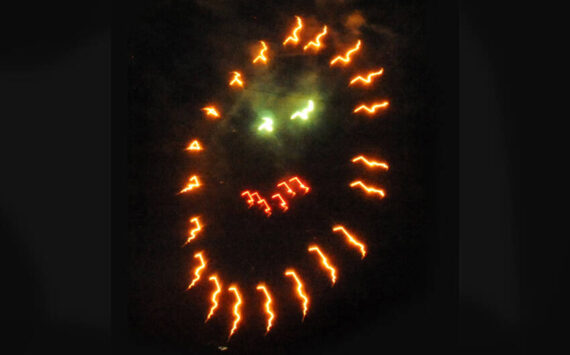
A view of the spillway of Enloe dam from the west bank of the Similkameen River. Okanogan County PUD recently released their Draft License Application to the Federal Energy Regulatory Commission for relicensing the hydroelectric dam.
OROVILLE – Okanogan County Public Utility District has decided to renew its efforts to obtain a license from the Federal Energy Regulatory Commission to restore Enloe Dam on the Similkameen River above Oroville in order to once again generate hydroelectric power.
The dam, which has not been used to make electricity since it was decommissioned in 1958, has the potential to generate an average five megawatts of power and up to nine megawatts at peak generation, according to Okanogan County PUD Commissioner Ernie Bolz.
“The board feels we should pursue a license in order to generate power which will be needed in the future and to secure Oroville’s system because there is currently only one line serving the north end.”
Boltz said the board feels it needs to secure as many resources for supplying power to its customers as it can for a reasonable cost for “now and in the long term.”
“Enloe is a small component, but an important one for the energy needs for the future of the county,” he said. “The Bonneville Power Administration resource is getting stretched thinner every coming decade. We need to find and build new generation — it can be difficult with the environmental constraints but we feel that Enloe can be as premium as one of those new resources.”
Dan Boettger, the PUD’s Director of Regulatory and Environmental Affairs, concurs with Commissioner Bolz. He believes the utility should pursue relicensing the dam as a way to generate power with little environmental impact. He says releasing the Draft License Application (DLA) is just the first step in the process toward restoring the dam to power production.
“It’s the first step in the process. The DLA is similar to an environmental review. It includes a comment period and we have put in a section of PMEs… Preventions, Mitigations and Enhancements,” said Boettger.
He said that the utility is about to release their fourth fact sheet, which will have a list of the PMEs in the DLA. “The fact sheet is focused-based on what we’ve heard during the process,” he said.
Several federal and state agencies will be involved in the process, especially the U.S. Bureau of Land Management, U.S. and Washington State Departments of Fish and Wildlife, NOA Fisheries, state Department of Ecology and the state Department of Natural Resources. The state Historical Preservation officer will also be involved, as will the Colville Confederated Tribes, according to Boettger.
FERC does not usually get involved in these discussions between the agencies and the license applicant, said Boettger.
“Typically FERC is not required to do more. They watch the interactions back and forth and at the conclusion of the DLA comment period if there’s a case where the BLM says ‘do something’ and we say ‘no’ FERC will look at both sides and make a decision.
“Generally we try to work everything out before FERC gets to that point.”
Both Boettger and Bolz discussed the benefits an upriver dam would have for power generation at Enloe.
The PUD has begun studying the possibility of a “high dam” being built upriver at Shanker’s Bend. In the past a high dam has been controversial because it would flood much of the land behind it and depending on its size back water up all the way to Canada.
A dam at Shanker’s bend of any size could help with power generation at Enloe, according to Bolz and Boettger, because water could be stored there and released more gradually and extending peak power production at Enloe for more than just spring runoff time.
“A high dam would mean the average power output would be higher because the annual flow would be more stable… it would even out the flow,” said Bolz.
At one time the high dam was controversial on both sides of the border, but Washington State has provided funding to study water storage projects including at Shanker’s Bend and the British Columbia government is taking a fresh look at water storage through a dam on the Similkameen on the Canadian side.
Boettger said a high dam could generate power at Shanker’s Bend as well as provide beneficial water storage and flood control while increasing the potential for longer periods of peak power production at Enloe.
There are three sizes of dams being studied for Shanker’s Bend, the tallest at 260 feet could produce 84 megawatts of power.
“Looking at the district’s current loads that size of production could fulfill all our average and half our winter peak needs,” said Boettger. “It would be a great side benefit to storing water.”
The problem with this highest of dams being studied is that it would more greatly affect the Canadian side of the border, while the two much smaller dams would not flood Canada, he said.
“The other two much smaller dams would still be able to generate between 12 and 30 megawatts,” Boettger said.
The high dam idea is entirely separate from the PUD’s current efforts to relicense Enloe, but it could become an important part of the picture if it ever received the okay and support needed for its construction.
Copies of the DLA are available for review at the Oroville and Okanogan offices of the PUD, as well as the Oroville, Tonasket, Omak and Okanogan Public Libraries. Hard copies can be ordered through the PUD at cost. The DLA can also be read and downloaded online at http://www.okanoganpud.org/enloe/DLA/Enloe%20DLA.html.
The 90 day public review and comment period began Nov. 7, 2007 and ends Feb. 4, 2008. Written comments may be submitted to Enloe Hydroelectric Project, Draft License Application Comments, 1331 Second Ave. North, P.O. Box 912, Okanogan, WA 98840 or via email at enloe@okpud.org.
Questions about the project can be addressed to Boettger at (509) 422-8425 or Nick Christoph, Environmental Coordinator, at (509) 422-8472.






